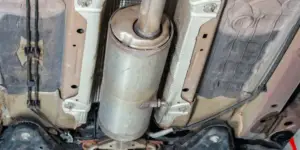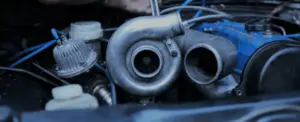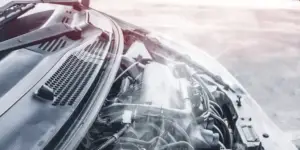There are five main reasons why your coolant has stopped circulating. Here we will examine each in detail – along with the costs of repair.
Briefly though, if your coolant isn’t circulating, it would be because either:
- Radiator is Blocked
- Thermostat Has Gone Bad
- Air in the System
- The Water Pump is Broken
- The Serpentine Belt is Broken
Let’s look at these in more detail,
Radiator Blockage
How A Radiator Works
The hot coolant is pumped to the radiator by the water pump and is cooled by the radiator. The radiator sits at the front of your car under the hood and has many fins on it where the water and coolant flow.
As it is doing so, it is cooled by the air from outside entering the car grill and then passing over the radiator. This motion at speed cools the coolant before it leaves the radiator from the bottom house and travels back to the pump.
How A Car Radiator Stops Working
Radiators fail in one of two ways.
Firstly they can leak. This may be because of corrosion – which is more possible if the coolant is too diluted or hasn’t been changed at regular intervals, or through a stone getting through the grill and hitting it.
Often, the cause will be a build up of sludge – again caused by a badly maintained cooling system. The coolant goes on quite a journey, through hoses, a water pump, the hot engine, and onto the radiator. Sludge is a natural symptom of the heat and cooling and interaction with rubber and metal too.
Diagnose Blocked Radiator.
A really simple test. Be safe, though, and keep away from the radiator fan – as they can stay on even when the engine is turned off.
Feel the top-inlet – hose. It should feel hot.
Lean down and feel the temperature of the outlet hose at the bottom of the radiator. It should be warm – maybe not as hot as the top hose as the coolant inside the radiator has been cooled before entering the bottom hose.
If the bottom hose is cold, that indicates a blockage within the radiator – but not always.
How To Unblock A Car Radiator
You’ll need to flush through all the sediment that has collected in the radiator. There is a chance – although unlikely – that the radiator is too clogged to be saved. Here’s a guide with pictures on How To Unblock A Car Radiator (Opens in a new tab)
Radiator Repair or Replacement Cost
You can flush through the radiator yourself with minimal tools. All you’ll need is a flushing agent and new coolant. Expect this to cost around $30 in total. A car shop will charge around an hour’s labor for this if you’d prefer not to get your hands dirty.
A brand new fitted replacement radiator costs in the region of $300 to $600 depending on the make and model of your car. Labor costs will be $75 to $130 for an hour. It shouldn’t take longer than this.
Thermostat Stuck In Closed Position
How the Thermostat Works
In simplest terms, the thermostat is a valve that sits between the engine and the radiator.
The thermostat contains wax that expands and contracts. It’s quite a simple device, actually.
When the heat reaches a predetermined temperature, the compound increases in size, which activates the valve.
The compound shrinks when the heat dissipates, reopening the valve.
The valve opens when the coolant in the engine becomes too hot, allowing it to escape to the radiator to cool down.
As long as the thermostat is closed, the coolant continues to run inside the engine block and keeps the engine at the proper temperature.
This is fine as the engine needs to be warm enough to operate efficiently, but if it gets too hot and the valve remains closed, the hot coolant gets hotter, and the engine overheats.
Where Is The Thermostat and What Does It Look Like?
The thermostat is flat circular and has a small screw sticking out of the top of it. Sometimes the dome on top of it is yellow. It is usually found right next to the water pump.
The water pump is normally found at the front of the engine. Look for a large piece of metal with a hose going in and one leaving. Or follow the upper radiator hose back to the water pump, and you can find it that way.
Here is a good video that will show you ways of checking the thermostat is working without removing it to see.
Thermostat Replacement Costs
The part itself should not cost more than $40, and labor should cost no more than $75. It is a job that a DIY mechanic can perform with little difficulty.
Air Blockage In Cooling System
Air blocking any part of your car’s cooling system will result in either your car running hot or cold, depending on where the blockage is. If the blockage is in or around the water pump – it often is – this will result in the hot coolant not being allowed to circulate to the engine. The radiator and both hoses in and out will stay cold.
The airlock can move around, though, and the only way to get rid of it is to open the circuit and let it out.
How did the air get in the system anyhow? Well, when the coolant is changed, air can get in. What should happen is the air is expelled before the car is handed back to the customer if a mechanic did the change or by you if you did the change.
Any leaking coolant will be replaced in the system by air which fills the void left by the coolant.
How To Remove Air From The Coolant System
As air finds its way to the highest point in the system, park your car on an incline as this will force it to move to the front of the car.
After that, open the bleed screw that you can find by the water pump. With the engine running start to add coolant through the radiator cap until you see coolant leaking out of the bleed screw. Here’s a great video to show you what to do for a full breakdown step by step.
Water Pump Not Working
The Water Pump Works Like This.
Keeping the coolant flowing through the engine block, cylinder head, hoses, and the radiator is crucial to maintaining an engine’s ideal temperature.
An engine’s crankshaft pulley or sprocket drives it using a belt. Coolant is moved through the cooling system by the pump’s impeller blades and centrifugal force.
Having flowed around the engine, the coolant is taken through a hose to the radiator, entering at the top. After being cooled by the movement of air over the radiator’s fins, the coolant leaves through the bottom hose.
The water pump receives the cooled coolant back before sending it on its way again back to the engine.
How A Water Pump Breaks Down
The impellers in some pumps are made of plastic, which sometimes break. The uneven movement caused by this contributes to the pump failing. It is also possible for the impeller to become loose on the shaft, causing the pump not to spin at all.
Water pumps with worn bearings produce grinding or rattling sounds. Even though it may be possible to replace the bearings, the seals will likely be damaged as well.
When the shaft seal fails, the whole pump must be replaced, but when the gasket fails, the pump can be disconnected, a new gasket installed, and the original pump put back on.
Coolant leaking from the water pump could indicate that the shaft seal or gasket between the pump and engine has worn out.
Normally, the entire pump is replaced as a precaution – pumps aren’t that expensive.
Water Pump Replacement Cost
The cost of a replacement water pump ranges between $150 and $300. Add on between $150 and $250 in labor too. The total cost, therefore, ranges between $300 and $550 in total.
Serpentine Belt or Timing Belt Problem
Depending on the make and model of your car, your car’s water pump is powered by one of these two belts.
This is an unlikely cause, though, as the serpentine belt also powers other components and systems in the car like the power steering pump, the air-con compressor, and the alternator.
If the serpentine belt powers your car’s water pump, you would also be experiencing problems with these systems too.
If the timing belt or chain powers the water pump, you would have probably experienced a ticking noise in your engine and misfires.
If you can’t say yes to any symptoms in this section the belts are not the cause of the coolant not being circulated.
In Conclusion
A new water pump may be required if the coolant is not circulating. Only after you’ve made sure the thermostat is functioning right should you inspect the water pump.
It’s never good to have your coolant not circulating around the system. It can cause the engine to overheat – never a great idea.
Luckily the repairs are cheap, and a DIY mechanic can carry out most without too much difficulty.






![Car Temperature Gauge Stays On Cold - [ALL CAUSES] Cold-temperature-gauge](https://carzaza.com/wp-content/uploads/2023/12/Cold-temperature-gauge-300x161.png)






